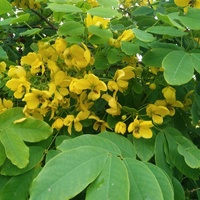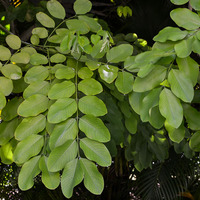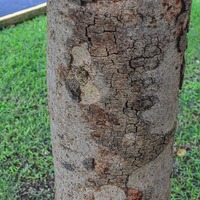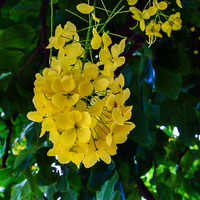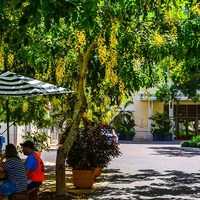Common name: Shower of gold
Other common names: Golden shower, Indian laburnum, Indian senna, Pudding pipe tree, Purging cassia
Description
Shower of gold is a spectacular flowering tree originating in India, with a natural distribution scattered over much of the subcontinent and occurs in both dry and moist deciduous forests.
It is typically 10 to 15 m (30 to 50) tall, usually with a single trunk, though sometimes multiple-trunked and develops a densely branched crown of variable shape, from narrow to round or wide-spreading, depending on the growing conditions. The bark is smooth and yellowish on young trees, becoming dark grey, cracked and flaking off in patches on older trees.
Leaves are large and feathery, consisting of oval leaflets arranged in pairs along the length. These emerge copper-coloured and softly hairy, then with age become light- to medium-green. Most fall off the tree to conserve water during the dry season, leaving the branches bare until the rainy season, which encourages new growth.
Around the same time as the new leaves emerge, the tree bursts into bloom, producing masses of bright yellow flowers held in long, pendant clusters. These are followed by thin, cigar-shaped seedpods up to 70 cm (2.3 ft) long. Green when young, they become near black when mature and persist unopened on the tree for months.
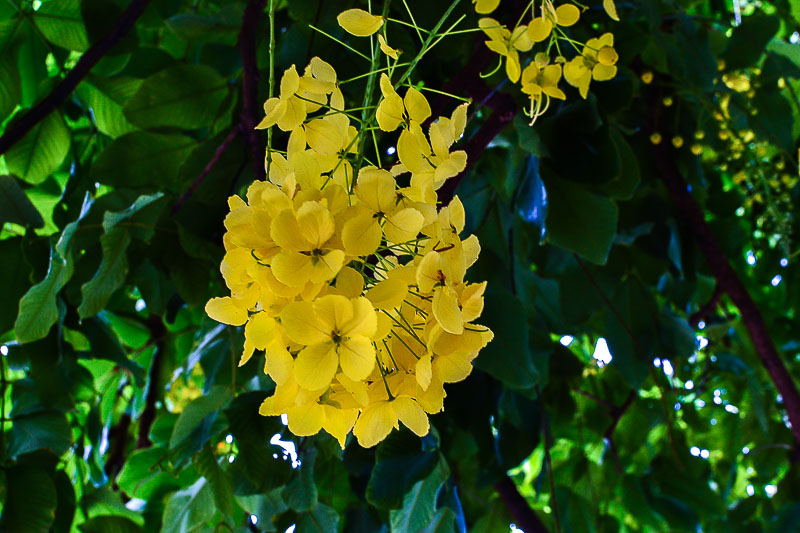
Use
Shower of gold is a commonly cultivated tree in gardens and landscapes, including streetscapes and coastal areas for its showy flowering display and high tolerance to salt spray.
It produces a heavy wood, averaging around 800 kgs per cubic meter (50 lbs per cubic ft) with brick-red heartwood and moderate natural resistance to decay. Although this puts it in the durable hardwood class, the logs mostly come in diameters too small for sawing into beams, planks or lumber. They are more usually used for poles, posts, turnery, tool handles, firewood, and charcoal.
The fresh-cut leaves are palatable to livestock and nutritious, with a dry weight protein content of around 17%.
The bark is a source of tanning in India traded under the name 'Sumari'.
Health use
The seedpods and pulp contain the Anthraquinone, a stimulant-laxative compound known to increase intestinal motility and intestinal secretion. In parts of its native range, the pulp, which is sticky and slightly sweet, is dried and used to relieve constipation. The stripped bark is used in medicinal preparations to act as a purgative.
Climate
Grows and flowers reliably in sub-humid to humid subtropical and tropical lowland to mid-elevation climates, generally areas with annual lows of 13 to 25°C, annual highs of 22 to 35°C, annual rainfall of 700 to 4500 mm and a dry season of 8 months or less, extending to 12 months with irrigation or groundwater.
Growing
New plants are usually grown from seed which remain viable for months when dried and stored under cool, dry, airtight conditions. Germination is improved by soaking the seed in pre-boiled, hot water for five minutes before planting.
Performs best on free-draining sand and loam soils of a slightly acid to neutral nature, generally with a pH of 6.0 to 7.0 and on sites with full- to partial sun exposure.
Problem features
Reports on its weediness are conflicting. It is assessed as a low weed risk species for Hawaii and Florida, respectively, by the Hawaii Pacific Weed Risk Assessment project (HPWRA) and the IFAS Assessment of Non-Native Plants in Florida's Natural Areas. However, in Australia, it is recorded as a weed of agriculture, a serious weed class.
In India, it is reported as a major source of irritating pollen that contributes to causing hay fever in some people. The roots are moderately vigorous, and a minimum planting distance of six meters from underground pipes is recommended.
Where it grows
References
Books
-
Adams, C. D. 1972, Flowering plants of Jamaica, University of the West Indies, Mona, Greater Kingston
-
Allen, O. N. & Allen, E. K. 1981, The Leguminosae : a source book of characteristics, uses, and nodulation, University of Wisconsin Press, Madison, Wisconsin
-
Barwick, M., et al. 2004, Tropical & subtropical trees : a worldwide encyclopaedic guide, Thames and Hudson, London
-
Dastur, J. F. 1964, Useful plants of India and Pakistan : a popular handbook of trees and plants of industrial, economic, and commercial utility, 2nd ed., D. B. Taraporevala Sons, Bombay
-
Fawcett, W. 1891, Economic plants, An index to economic products of the vegetable kingdom in Jamaica, Jamaica Government Printing Establishment, Kingston
-
Florida Department of Environmental Protection 2010, The Florida-Friendly Landscaping Guide to Plant Selection & Landscape Design, 1st ed., University of Florida
-
Gilman, E. F. 1997, Trees for urban and suburban landscapes, Delmar Publishers, Albany, New York
-
Gohl, B. 1981, Tropical Feeds : feed information summaries and nutritive values (Revised edition), Food and Agriculture Organization of the United Nations (FAO), Rome
-
Hall, N. 1972, The use of trees and shrubs in the dry country of Australia, Australian Government Publishing Service, Canberra, Australian Capital Territory
-
Hocking, D. 1993, Trees for drylands, International Science Publisher, New York
-
Holttum, R. E. & Enoch, I. C. 2010, Gardening in the tropics : the definitive guide for gardeners, Marshall Cavendish Editions, Singapore
-
Howes, F. N. 1949, Vegetable gums and resins, Chronica Botanica Company, Waltham, Massachusetts
-
Jensen, M. 1999, Trees commonly cultivated in Southeast Asia : an illustrated field guide, 2nd ed., Food and Agricultural Organisation of the United Nations (FAO) Regional Office for Asia and the Pacific (RAP), Bangkok
-
Krishen, P. 2006, Trees of Delhi : a field guide, Dorling Kindersley Publishers, Delhi
-
Luna, R. K 1996, Plantation trees, International Book Distributors, Dehradun, Uttarakhand
-
Macmillan, H. F. 1943, Tropical planting and gardening : with special reference to Ceylon, 5th ed, Macmillan Publishing, London
-
Martin, F. M., et al. 1987, Perennial edible fruits of the tropics : an inventory, U.S. Dept. of Agriculture (USDA), Agricultural Research Service, U.S. Government Printing Office (GPO), Washington, D.C.
-
Parrotta, J. A. 2001, Healing plants of peninsular India, CABI Publishing, Wallingford, Oxfordshire
-
Perry, F. & Hay, R. 1982, A field guide to tropical and subtropical plants, Van Nostrand Reinhold Company, New York
-
Polunin, Ivan 1987, Plants and flowers of Singapore, Times Editions, Singapore
-
Prasanna, P.V. 2012, Trees of Hyderabad: A Pictorial Guide, 1st ed., Botanical Survey of India (BSI), Indian Government Ministry of Environment and Forests, Kolkata
-
Randall, R. P. 2002, A global compendium of weeds, R.G. and F.J. Richardson Press, Melbourne
-
Randall, R. P. 2007, The introduced flora of Australia and its weed status, Cooperative Research Centre for Australian Weed Management, Glen Osmond, South Australia
-
Scheffer, T. C & Morrell, J. J. 1998, Natural durability of wood : a worldwide checklist of species, Forest Research Laboratory, Oregon State University, Corvallis, Oregon
-
Selvam, V. 2007, Trees and shrubs of the Maldives, Food and Agriculture Organisation (FAO) RAP publication (Maldives), Thammada Press Company Ltd., Bangkok
-
The Garden Section of the Woman's Club of Havana 1958, Flowering plants from Cuban gardens : Plantas floridas de los jardines cubanos, Criterion Books, New York
-
Vozzo, J. A 2002, Tropical tree seed manual, U.S. Department of Agriculture (USDA), Forest Service, Washington D.C.
Articles, Journals, Reports and Working Papers
-
Morton, J.F. 1964, Honeybee Plants of South Florida, Proceedings of the Florida State Horticultural Society, Vol 77:415-436.
-
Singh, A. B., & Kumar, P. (2003). Aeroallergens in clinical practice of allergy in India. An overview. Annals of Agricultural and Environmental Medicine, 10(2), 131-136.
-
Singh, K. P. & Kushwaha, C. P. 2006, Diversity of flowering and fruiting phenology of trees in a tropical deciduous forest in India, Oxford University Press
